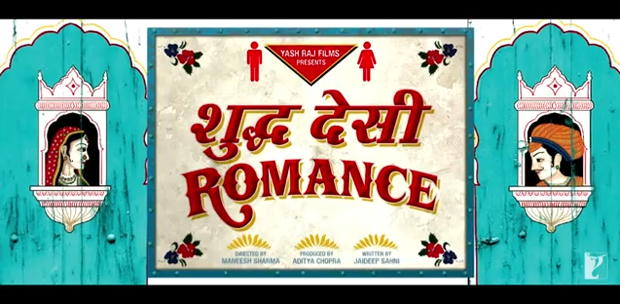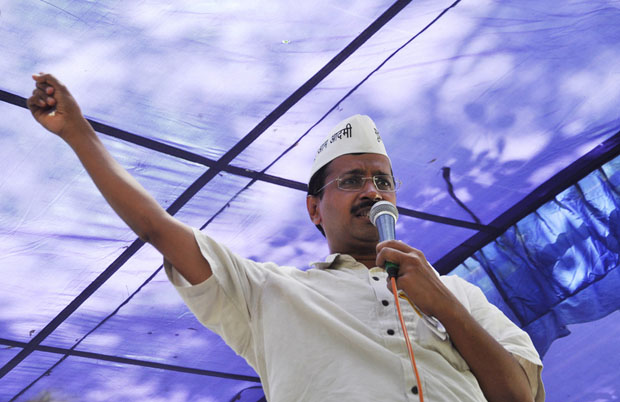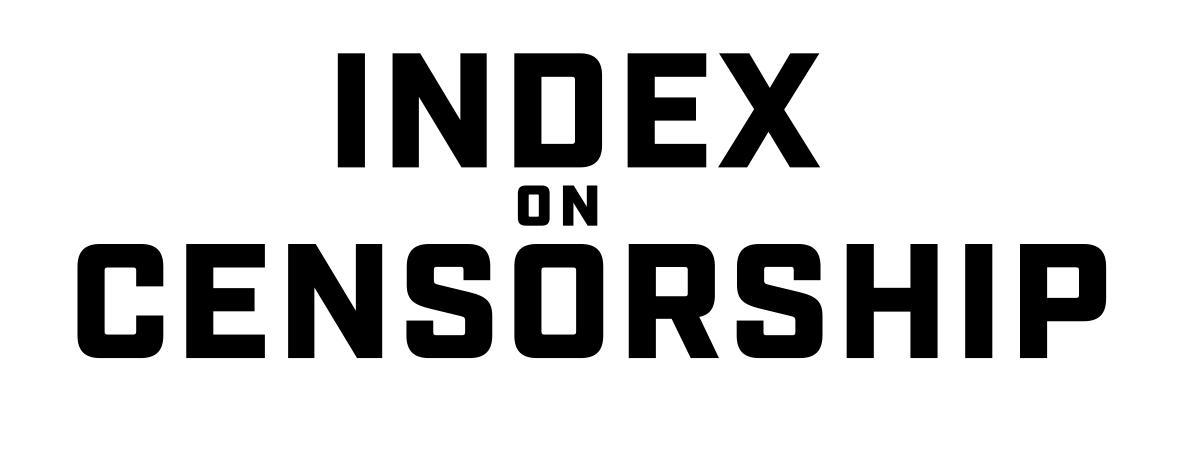30 Jan 2014 | India, News, Politics and Society, Religion and Culture

(Image: YRF/YouTube)
It an interesting introduction to his modus operandi, the new CEO of India’s censor board has described his objection to some of India’s recent blockbusters is based on the reactions of his wife and five year old daughter.
In an interview to the Mumbai Mirror, Rakesh Kumar, was quoted as saying: “After watching Shudh Desi Romance, my five-year-old daughter asked me, ‘Dad, isn’t there too much love in this movie?’ More recently, I went to see Yaariyan with her and came out visibly embarrassed. Now, I have decided not to see even a UA film with my kid.”
Predictably, reactions were fierce. Movies with a UA rating in India are tagged for parental guidance, as they might be inappropriate for young children. These movies have mild sex scenes, gory images of violence and crude language. Kumar, a former employee of the Indian Railways, might feel “inappropriate content” is making it to the big screens, however, it only serves to highlight that the censorship of movies cannot be viewed from the perspective of a five year old girl.
Aside from the many jokes being made at Kumar’s expense, a deeper issue has been brought to the surface yet again. A constitutionally mandated body under the Ministry of Information and Broadcasting, the Central Board of Film Certification (CBFC) regulates any films that are to be publicly exhibited. In India, there are a number of certificates a film could be given: A for Adult, UA, unrestricted public exhibition with parental guidance, S, restricted to a special class of persons, and the coveted U, which is unrestricted public exhibition, and is also the class of movies that can be shown on Indian television at prime time.
The first question many might ask is, does India need a censor board? With all kinds of content available on television and the internet, is censoring film for “inappropriate” content still valid? However, given that India does have a censor board, the next question is who it is made up of. There are about 500 members of CBFC, who preview around 13,500 films a year. The current chair is a famous dancer, Leela Samson, who controversially commented that almost 90% of her fellow board members were “uneducated political workers who did not understand their responsibility,” for which she later had to apologise. The current, and past, CEO of the board have been serving bureaucrats, on loan for this role. The final and biggest questions of the censor board faces, is how and why films are given the certifications they are.
In a very telling essay after his stint on the CBFC, journalist Mayank Shekhar wrote about the kinds of arguments that would take place at the meetings he attended: “Over the years, the focus of the Censor Board appears to have shifted from sex and violence to people’s “hurt sentiments” – some of it possibly real, but much of it imagined.”
The truth is that there are three broad problems in the certification of Indian films. First, the film board censors movies based on their moral outrage to sex or violence (as exhibited by the new CEO’s reaction), fear of minority groups getting upset (as witnessed by Shekhar), and the attempt to keep films with controversial subjects like the politics of Kashmir away from the mainstream audience, often by giving them A certification (as experienced by filmmaker Ashvin Kumar and reported by Index).
The second is the approach of filmmakers. Some, in order to get their films on TV by getting a U certificate, are only too happy to oblige any cuts the board might suggest, betraying any artist integrity. The other extreme is filmmakers who put in scenes with the intention of crossing swords with the board, thereby garnering some press attention for the movie. Shekhar writes in his essay of producer who was very disappointed that the board was not cutting any of his violent scenes, pleading: “Come on, how will people know this film exists? I’ve made a very violent film. How will I publicise it?”
The third is the allegation that board members take bribes in exchange for lenient certifications, as reported by Mint. Some feel the board goes easy on big production houses. This is because there are great financial implications involved with the certification process. Filmmakers want to make their investments back, both from the box office and lucrative satellite rights should their films be picked up for prime time viewing on television channels — as they can be with a U rating. Five Indian filmmakers have expressed their frustration with the lack of transparency in the decision making process of the CBFC, as well as perceived political interference. “I got an SMS from a senior member of a national political party, who told me that he was now with the Censor Board so to let him know if I needed any help,” revealed filmmaker Tigmanshu Dhulia.
However, ultimately, the entire argument boils down to the moral order, real or contrived, that Indian films must subscribe to should they want to be seen by the general public — both in movie halls and at a reasonable hour on television. In 1994, the censor board asked the makers of the movie Khuddar to replace the word “sexy” in a song with the word “baby”. So lyrics went like this (translated) – “baby, baby, baby, is what people call me.” In a repeat performance of a kind, in 2009, the world “sexy” was yet again replaced, but this time with “crazy” for the television version of the film. Over the years, kissing and even some sex scenes have slipped into Hindi cinema, as has a lot of cussing and plenty of violence. Nudity is only permitted in certain movies, which is either pixelated or viewed by a long-shot. Freedom of expression certainly seems in line behind the perceived notions of vulgarity of a few.
Thankfully, satire is alive and well in India, and enough websites are taking the CBFC and its new CEO to task. Others, like filmmaker Hansal Mehta, are determined to file an RTI – Right to Information – application to question every decision the board takes. As he says: “It only takes Rs 10 (under 1GBP) to file an RTI application. We live in a democracy, no one can stop me.”
This article was published on 29 January 2014 at indexoncensorship.org
16 Jan 2014 | India, News, Politics and Society, Religion and Culture

It is almost impossible to believe, but the government of India’s largest and most populous state, Uttar Pradesh, has been accused of taking the country’s most popular (and shrillest) English news channel, Times Now, off the air following a wave of critical reporting. The so-called ban also extended to another channel, India News. The move led to a widespread backlash, and both channels have been restored. The Samajwadi Party government led by Akhilesh Yadav claims it was a technical glitch and not a targeted strike against its critics.
While the background causes for the ban were slowly built up over time, the immediate one was Times Now’s dogged coverage of a star-studded Bollywood event that cost “crores”, thrown by the Uttar Pradesh government – a festival called “Saifai Mahotsav.” This came at a time when victims of a riot in the town of Muzzafarnagar have been left in the bitter cold to fend for themselves in relief camps. Juxtaposing images of the young Chief Minister watching nubile Bollywood starlets gyrate to the latest hit songs with images of a little child shivering in relief camps, the channels demanded to know, among other things, why the event was taking place and where the money was coming from. The brutal Muzzafarnagar riots, which took place in late August 2013 between Hindus and Muslims in the community, ended with over 1800 Muslim families being displaced from their homes. The Indian media has routinely been reporting on the problems of resettlement, the cold, the dismal conditions of the camps and the victims’ complaints of foul play by officials there. Given this background, the glamorous Saifai festival became a rallying point for TV channels. They also started reporting that five ministers from the Uttar Pradesh government were on a foreign junket while riot victims were still suffering. The criticism against the government was loud and unforgiving, and in some cases, unrelenting.
Soon the editors of both Times Now and India News received reports that their channels were blocked across many cities and towns of Uttar Pradesh. As it stands, it seems the ban was applicable to those still watching cable and was not implemented over Direct-to-Home satellite systems. According to the Indian media, cable operators unofficially admitted that they were being pressurised by the government. The president of the Cable Service Consumer Protection Committee, Ambika Prasad Ojha told the Times of India that “the telecast of Times Now and India News has been stopped across UP because the CM got offended by their negative coverage of the Saifai Mahotsav.” Online media channel Newslaundry reported that they were unable to find any official communication ordering a ban.
In light of the increased criticism, the Uttar Pradesh government has defended itself saying that, “the [Samajwadi] party respects media freedom and that there must be some technical error and nothing else.” The Chief Minister gave an interview explaining that the festival is to boost tourism and industry in the state and has been portrayed in a bad light by the channels, and took offence to much of the language used in their reports. Party spokesperson Gaurav Bhatia singled out the word “debauchery” that Times Now’s main anchor had used to describe the festival. In the same interview, the Chief Minister talked about an interview he gave a year ago that was vetoed by the sales and marketing department of the channel, hinting that incessant coverage of the timing of the festival was not due to its newsworthiness, but to gain viewers. He even complained that the channels did not mention that the same Bollywood stars who attended Saifai Mahotsavalso, also visited sick children in hospitals.
While the young Chief Minister might feel persecuted for holding an annual festival – riot or no riot – the cable operators admissions have heavily hinted that there has been behind-the-scenes muzzling of the media. That coupled with the fact that two very vocal critics were taken off the air in the wake of heightened negative coverage does not bode well for neither the Uttar Pradesh government’s lip service to media freedom, nor media freedom in India on the whole. The incident has taken place without anyone going to an industry association with a formal complaint or a formal order for a short-term ban (as happens from time to time in India when channels break rules). The Information and Broadcasting Minister, Manish Tewari, made a statement saying that, “I think it is extremely unwarranted, it is extremely uncalled for and if at all any channel has been taken off the air for malicious reasons or a malafide reason, it is extremely uncalled for that freedom of speech and expression is trampled upon in this manner.” Tellingly, the Minister had just finished a speech in which he had said that in broadcasting, if content is king then distribution is God.
Ultimately, unless it can be proven that cable operators stopped the transmission of Times Now and India News on purpose, the story will remain mired in allegations. However, the public sentiment on social media seems to agree that the channels were unfairly targeted. What this exposes is the lack of rules when in face-offs between politicians (or perhaps, ruling politicians) and the media. Earlier reports on the Congress government have centred on requests to Google to take down posts that criticised it, as well as cases of social media users being arrested for comments critical of politicians. In this case, it seems, instead of either ignoring the criticism, or filing a formal complaint, the state government simply bullied cable operators into taking the channels off air. For a country that prides itself on a diverse and robust media environment, it is yet another in a long list of warning signs that press freedom is certainly not to be taken for granted and need to be protected at all costs.
This article was published on 16 Jan 2014 at indexoncensorship.org
6 Jan 2014 | Digital Freedom, India, News, Politics and Society

Social media played a significant part in Arvind Kerjiwal’s successful campaign to become chief minister of New Dehli. He is pictured here addressing auto drivers at a protest in June last year (Image: Rohit Gautam/Demotix)
Much has been written about the influence of social media in the upcoming Indian national elections, expected to take place in mid 2014.
While the two major political parties, the Congress and BJP, have invested in social media cells, the larger consensus is that the internet is still largely an urban phenomenon, and therefore, somehow, not important. According to the latest TRAI figures, rural tele-density still stands at 42%. However, the flip side is that urban tele-density, currently at 144.28%, has allowed the cities to become a litmus test of what could happen if the population was able to access the internet, therefore social media, during election time.
Against the backdrop of social media giving the average citizen a voice to express often ignored opinions, came the anti-corruption protests of 2011, led by Gandhian Anna Hazare and his commander-in-chief, former bureaucrat Arvind Kejriwal. As the two spearheaded a campaign to fight against the injustices meted out to the common man through an oppressive political system, and fought for an anti-corruption law to be passed, they found an onslaught of support over social media by the middle class. Even the TV news channels got caught up in the noble theatrics, keeping the cameras live at Anna Hazare’s hunger strike in the capital, attracting more viewers, and also more supporters for their cause.
Two years later, the bill has been passed – but Team Anna, as it was popularly called, split into two factions The first remains under the leadership of Anna Hazare, and has dissipated into the background. The second, however, has only grown in size and stature. Arvind Kejriwal, in perhaps the most maverick of moves, sits in the capital of India today as its chief minister. This, with a groundswell of support not just from the haggard residents of New Delhi, but seemingly growing support from all over the country. Many factors have contributed to this rise; however, one can certainly identify the role of social and citizen media in shaping this particular election, especially when it comes to Delhi’s middle class.
Kejriwal formally formed the Aam Aadmi Party in November 2012, which translated means the ‘Common Man Party’. They decided to contest the 2013 Delhi elections, with Kejriwal directly taking on three time Congress Chief Minister, Sheila Dixshit, in her constituency. He defeated her.
The Aam Aadmi Party today has 1, 137, 873 likes on Facebook. People can donate to the party online, and follow its leaders on Twitter. What’s more, in a clear and concise website, AAP lists out its manifesto, explanations about its constitution and decisions and even an internal complaints committee. It has a video link, a blog, and even an events page so that people can join in. As it gears up for the 2014 national elections, AAP is also inviting nominations for candidates online. This is unheard of in Indian politics, where politicians are born out of birthright or bribes.
As elections in Delhi were underway, Indian media reported that Kejriwal had admitted to learning from Barack Obama’s social media strategy of 2008, which many believe helped him win the White House. Seven thousand dedicated volunteers consisting of students, workers, people on sabbatical from their jobs, and even retired government officials joined to help AAP rise to power. They collected roughly $1.8 million USD for the campaign in 2013. After the campaign was over, analysts revealed the success of AAP with first time voters: AAP’s online coordinators talk of reaching 3.5 million people just before voting day with an app called Thunderclap, which sits on your Facebook page and tells you to go vote. There seemed to be some sort of social media pressure to be trendy and go vote when it came to the youth of Delhi. However, when it came to its low-income group supporters, AAP did not rely on the power of social media, but implemented a door-to-door strategy which would work in that demographic.
AAP has not been without its share of controversies, the most recent of which was deftly handled through opinion polling over telephone and social media. Kejriwal had announced that in the cause of a hung election in Delhi, his party would absolutely not take the support of either the BJP or Congress to form government. The situation played out exactly as they hoped it wouldn’t. So as to not go back on his word, but still have the option of forming government, AAP decided to ask the people what to do. Suddenly, the people of Delhi could vote in various ways, advising Kejriwal on what he should do. After the polls closed, Kejriwal declared that overwhelmingly, AAP supporters wanted him to form government, which he did. As expected, the BJP has alleged that the “so-called referendum” was actually members of the Congress Party spamming the poll to ensure AAP took Congress support to form government, thereby letting the defeated Congress government regain a position of power.
The takeaway from Kejriwal’s success is that social media buzz, leading to (or perhaps caused by) the mainstream media coverage, has effectively resulted in a small time activist now sharing prime time space with Prime Ministerial candidates like the Congress’s scion Rahul Gandhi and the BJP’s Narendra Modi. In the virtual world, the scales are shifting. The Times of India reports that television channels and social media immediately latched on to AAP leader Arvind Kejriwal as the new ‘hero’ who has since then been eating into Modi’s turf – that of the ‘public mind space’. In this war for public attention, Kejriwal seems to be gaining ground at Modi’s cost.
The Aam Aadmi Party and Arvind Kejriwal have certainly cornered the market on becoming heroes for promises made, aided by a masterful communication strategy. But there is more to this. Indians – residents of New Delhi – finally were able to participate in the interactive social media political campaign that they had previously only read about. The promise of an active democracy where the political leaders don’t just dictate terms but actually solicit and respond to the common man is too tempting an offer to ignore. In his first few days in office, Delhi’s new chief minister was unable to come in to the office, and almost comically tweeted that he was held back because of “loose motions.” The joke goes that perhaps some filters are necessary on social media!
However, irrespective of whether AAP delivers on all its promises or is somehow muscled out of office in a few months, it has proven something to all Indian media watchers. Social media buzz has helped in shaping the agenda for India’s largest and most important city, making a newly formed political party into a serious player in just over a year. This is significant as India has over 360 political parties, and space is limited on the national stage. With a few months to go until the national elections, one can expect more articles in the newspapers, listing out how other politicians have suddenly found the value of interacting with the common man over Facebook and Twitter, helpfully answering questions and taking feedback.
This article was p0sted on 6 Jan 2013 at indexoncensorship.org
3 Jan 2014 | Digital Freedom, News

Chinese websites
In 2010 China shut down 1.3 million web sites with popular pages, such as Facebook, YouTube and Twitter, blocked. Three years later and China has employed over 2,000,000 people to monitor microblogging sites, a further clampdown on free speech in the country.
Having blocked major social media sites it’s not surprising that a large percentage of China’s hundreds of millions web users have turned to microblogging sites to offer up their opinions on society. Although the Beijing News stated that the monitors are not required to delete posts they view online they do gather data by searching for negative terms relating to their clients and compiling the information gathered into reports.
Weibo, China’s largest microblogging platform, has more than 500 million registered users who post 100 million messages daily. Postings on the website that criticise the Chinese government are often removed.
Global internet access
The internet is often taken for granted by those with regular and easy access to the online world. However, a staggering 4.6 billion people live without access to it; that’s around 68% of the global population. The number of internet users has grown by 566% since 2000 but considering the positive effects the internet can have on employment, communications and finances more of the world should have access to this valuable resource.
Africa has the poorest access to the internet; only 7% of total global internet usage comes out of the continent with, on average, 15.6% of the population using the internet.
YouTube
YouTube was bought by Google in 2006. Seven years later and localised versions of the video sharing site have been implemented in 56 countries, allowing for the content posted on to YouTube to be tailored specifically to the country it is serving. Although localising YouTube for specific countries can help with issues surrounding copyright, it also means that governments can block specific content from being uploaded and viewed on the website.
In Pakistan the online video sharing site has been banned since 2012. Google is looking to localise YouTube in the country, allowing the population access to the site, but only if the search engine makes it easier to block any blasphemous or objectionable content. Iran, Tajikistan and China are the only other countries with a block on YouTube.
India and the internet
India may be able to claim to be the world’s third largest internet user (behind the U.S and China) but that does not mean the country’s 74 million internet users have free access to the web. According to the Google Transparency Report, India leads the way in the number of take-down requests issued. Between July and December 2012 Indian authorities requested, without court orders, that 2,529 items be removed from the internet- a 90 percent increase from the first half of 2012.
In 2013 amendments were made to the Information Technology (Intermediaries Guidelines) Rules which stated, under Section 79 of the IT Act, that intermediaries had only 36 hours to respond to complaints or content deemed by regulators to be “grossly harmful” or “ethnically objectionable”. The clarification meant that this content does not have to be removed from the web, but failure to respond or acknowledge to the request within the short time frame, which does not take into account weekends or holidays, can result in a criminal procedure.
This article was posted on Jan 3 2013 at indexoncensorship.org




